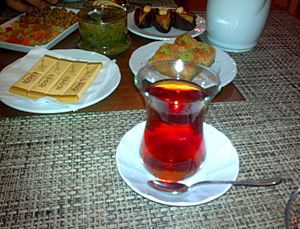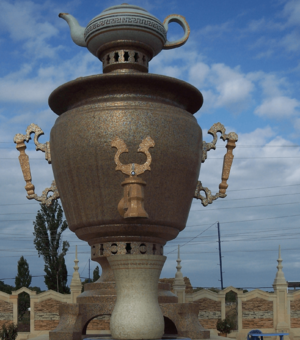Tea growing in Azerbaijan facts for kids
Tea growing in Azerbaijan happens in a special area of 5.33 thousand square kilometers. This area is called the Lenkeran-Astara region. It includes places like Astara, Lankaran, Masalli, Lerik, Yardimli, and Jalilabad. About 90% of all tea in Azerbaijan comes from Lankaran. This area is very close to the southern border with Iran.
People first started growing tea near the Caspian Sea in Azerbaijan in the 1880s. The weather here is perfect for tea plants. Because of this, the region now produces almost all of Azerbaijan's tea, about 99% of it.

Contents
History of Tea in Azerbaijan
Towards the end of the 1800s, a person named M. O. Novoselov planted the very first experimental tea bushes in the Lankaran District. In 1896, he even built a tea factory. By 1900, small test tea farms were set up in the area.
In 1912, Novoselov wrote a book called Russkiye subtropiki. This book talked about the best conditions for growing tea in the district. Around 1920, the tea growing efforts faced problems. After this, the Azerbaijan Institute of Gardening and Subtropical Plants started studying how to grow tea better. To help the tea industry grow, the Soviet Union increased tea production. This happened in the areas around Lenkaran and Zakatala.
In May 1949, leaders in Moscow made plans to grow more tea plants. They wanted to boost tea production in the Azerbaijan SSR. This would help the whole USSR have more tea. They did this by making more land ready for tea plants. By 1988, tea production in places like Georgia (country), Krasnodar Krai, and Azerbaijan grew a lot. It reached 38.5 thousand tons, mostly black tea.
In 1953, a new plan was approved to make tea farms even better. This plan included improving factories, tools, and irrigation systems. All these changes helped to produce much more tea. Today, Lövəyin, Khanbulanchay, and Vileshchay are the main places that supply water for tea farms.
In 1982, Azerbaijan produced 26 thousand tons of tea. By 1983, tea farms covered 9.3 thousand hectares of land. Most of this was for green tea, but black tea was also grown in Lankaran District. At that time, Azerbaijan was making enough tea to meet 65% to 70% of its own needs. The tea industry also gave jobs to 65,000 to 70,000 people.
In 1987, the Azerbaijan Government made a rule to grow even more tea. They planned to expand tea farms to 21,000 hectares by the year 2000. This would increase green tea harvests to 80–90,000 tons. Dry tea would increase to 20–22,000 tons. However, big events like the end of the Soviet Union and the first Nagorno-Karabakh War caused tea production to drop. By 1995, it fell to only 1,200 tons.
Where Tea is Grown Today
Azerbaijan's tea farms are located between the Caspian Sea and the Talysh Mountains. This area has a subtropical climate and lots of humidity. These conditions are perfect for growing tea.
The main areas for tea growing are in the districts of Lankaran, Astara, Lerik, Masalli, Zakatala, and Balakan. Most of the tea grown in Azerbaijan is for people to drink inside the country. But it is also sent to other countries like Turkey, the Russian republic of Dagestan, and Georgia.
In the Sheki-Zagatala economic-geographical region, tea growing is not as strong. Recent studies show that the weather in the South Caucasus might be good for new tea farms. The government has marked certain areas for future tea growing. The government is also working to help tea production grow again. They expect that by 2021, the amount of land used for tea will double.
The Tea Business
Sun Tea Azerbaijan is a large tea-packing factory. It has been working since 1996. It is one of the biggest tea-packing factories in the CIS. This company is a leader in the South Caucasus region. It produces about 15 thousand tons of tea each year.
The company makes pure green tea leaves at its main factories in Lenkaran and Astara. Here, they dry, twist, ferment, sort, and package the tea leaves. They mostly make packaged teas, green teas, and fruit teas. This tea is sent to the Caucasus, Central Asia, and the CIS, especially Russia.
For its main brand, Azerçay, the company uses leaves from local tea farms. They also get leaves from India, Vietnam, or Kenya. Their factory in Baku gets high-quality Ceylon teas from Sri Lanka through a company called Inter Tea. The factory often mixes Ceylon and Indian teas to create different types of tea. Each type has its own quality and mix of flavors.
Tea Culture in Azerbaijan
People in Azerbaijan really love drinking tea, which they call chay. They still follow old and traditional tea ceremonies. Tea is their main drink every day. It is common for guests in Azerbaijan to be offered black tea first. It is often served in a special pear-shaped crystal glass called an Armudu. People say this glass keeps the tea hot longer at the bottom and cools it faster at the top.
In Azerbaijani culture, offering tea at the start of a meal shows that you are a good host. People prefer sweetened tea. By tradition, sugar is never stirred directly into the tea. Instead, a sugar cube is dipped slightly into the tea before sipping it. This custom started a long time ago. In medieval times, people thought this was a way to check for toxins in the tea. They believed toxins would react with the sugar.
Azerbaijani people also like to add flavors to their tea. They use spices like cinnamon, lemon, or ginger. Tea is also made using fragrant herbs. Some examples are corn silk tea, mint tea, cinnamon tea, saffron tea, ginger tea, dog-rose tea, hawthorn tea, and thyme tea. Tea is often served with jams. These jams are made from fruits like figs, strawberries, apricots, walnuts, and blackberries. This jam is called dishleme, which means 'bite'. This tradition helps conversations flow easily.
Because many people in Azerbaijan love tea, almost every neighborhood has a tea house. These are called chaykhana. The chaykhor (tea expert) in a tea house knows that good tea should have a deep burgundy color. Purrengi (velvet tea) is the most common type of tea served in these places.
Historically, chaykhana were mostly for men. Women were not usually allowed in public places like these. The word chaykhana means a place where men drink tea. This tradition continues in Azerbaijan, similar to how Pubs in Britain once did not allow women. Chaykhanas are still places where men go to talk about important things or play a game of backgammon.
Drinking tea in Azerbaijan is also part of important events. These include celebrating an engagement, a marriage, the birth of a child, or a funeral.
Rules for Tea Growing
A special government plan for tea growing was approved on February 12, 2018. This plan will run from 2018 to 2027. Its goal is to help tea production grow. It also aims to increase how much tea Azerbaijan can sell to other countries. Another goal is to make sure people in rural areas have jobs.




